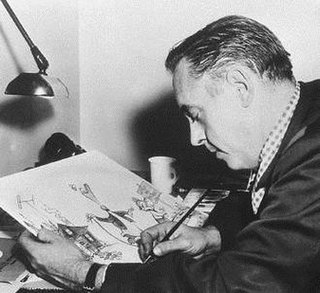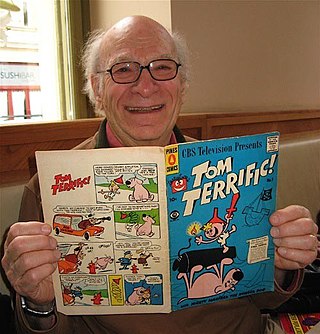Columbia cartoons
Tashlin directed the first film in the series, the 1941 Color Rhapsody short The Fox and the Grapes, based on the Aesop fable of that name. Warner Bros. animation director Chuck Jones later acknowledged this short, which features a series of blackout gags as the Fox repeatedly tries and fails to obtain a bunch of grapes in the possession of the Crow, as one of the inspirations for his popular Road Runner cartoons. [4]
Although Tashlin directed no more films in the series (despite playing a supervisory role on the following two shorts, Woodman, Spare That Tree and Toll Bridge Troubles, prior to his departure), Screen Gems continued producing Fox and the Crow shorts, many of them directed by Bob Wickersham, until the studio closed in 1946. [5] Screen Gems had acquired enough of a backlog of completed films that the "Fox and Crow" series continued through 1949.
By this time, Columbia had signed a distribution deal with a new animation studio, United Productions of America (UPA), to produce three "Fox and the Crow" shorts, Robin Hoodlum (1948), The Magic Fluke (1949), and Punchy De Leon (1950). All three UPA Fox and the Crow cartoons were directed by John Hubley. The first two each received an Academy Award nomination for Animated Short Subject.
An unrelated, six-minute, silent animated short titled The Fox and the Crow, produced by Fables Studio, was released in 1921. [6]
List of shorts
Screen Gems
In 1943, due to the series success, Columbia gave the Fox and the Crow their own series separate from the Color Rhapsodies; it lasted until 1946. All cartoons from Room and bored (1943) to Mysto-fox (1946) belong to this series.
| Film | Direction | Original release date | Series |
|---|
| The Fox and the Grapes | Frank Tashlin | December 5, 1941 | Color Rhapsody |
| Woodman, Spare That Tree | Bob Wickersham | July 2, 1942 | Color Rhapsody |
| Toll Bridge Troubles | November 27, 1942 | Color Rhapsody |
| Slay It With Flowers | January 8, 1943 | Color Rhapsody |
| Plenty Below Zero | May 14, 1943 | Color Rhapsody |
| Tree for Two | June 21, 1943 | Color Rhapsody |
| A-Hunting We Won't Go | August 23, 1943 | Color Rhapsody |
| Room and Bored | September 30, 1943 | Fox and Crow |
| Way Down Yonder in the Corn | November 25, 1943 | Fox and Crow |
| The Dream Kids | January 5, 1944 | Fox and Crow |
| Mr. Moocher | September 8, 1944 | Fox and Crow |
| Be Patient, Patient | October 27, 1944 | Fox and Crow |
| The Egg-Yegg | December 8, 1944 | Fox and Crow |
| Ku-Ku Nuts | March 30, 1945 | Fox and Crow |
| Treasure Jest | Howard Swift | August 30, 1945 | Fox and Crow |
| Phoney Baloney | Bob Wickersham | September 13, 1945 | Fox and Crow |
| Foxy Flatfoots | April 11, 1946 | Fox and Crow |
| Unsure Runts | Howard Swift | May 16, 1946 | Fox and Crow |
| Mysto-Fox | Bob Wickersham | August 29, 1946 | Fox and Crow |
| Tooth or Consequences | Howard Swift | June 5, 1947 | Phantasy |
| Grape Nutty | Alex Lovy | April 14, 1949 | Color Rhapsody |

Oswald the Lucky Rabbit is an animated cartoon character created in 1927 by Walt Disney and Ub Iwerks for Universal Pictures. He starred in several animated short films released to theaters from 1927 to 1938. Twenty-seven animated Oswald shorts were produced at the Walt Disney Studio. After Universal took control of Oswald's character in 1928, Disney created a new character similar in appearance to Oswald as a replacement: Mickey Mouse, who went on to become one of the most famous cartoon characters in the world.

Gerald McBoing-Boing is an animated short film about a little boy who speaks through sound effects instead of spoken words. It was produced by United Productions of America (UPA) and given wide release by Columbia Pictures on November 2, 1950. It was adapted by Phil Eastman and Bill Scott from a story by Dr. Seuss, directed by Robert Cannon, and produced by John Hubley.

United Productions of America, better known as UPA, was an American animation studio and later distribution company founded in 1941 as Industrial Film and Poster Service by former Walt Disney Productions employees. Beginning with industrial and World War II training films, UPA eventually produced theatrical shorts for Columbia Pictures such as the Mr. Magoo series. In 1956, UPA produced a television series for CBS, The Boing-Boing Show, hosted by Gerald McBoing Boing. In the 1960s, UPA produced syndicated Mr. Magoo and Dick Tracy television series and other series and specials, including Mister Magoo's Christmas Carol. UPA also produced two animated features, 1001 Arabian Nights and Gay Purr-ee, and distributed Japanese films from Toho Studios in the 1970s and 1980s.

The golden age of American animation was a period in the history of U.S. animation that began with the popularization of sound synchronized cartoons in 1928 and gradually ended in the 1960s when theatrical animated shorts started to lose popularity to the newer medium of television. Animated media from after the golden age, especially on television, were produced on cheaper budgets and with more limited techniques between the 1960s and 1980s.

Terrytoons was an American animation studio in New Rochelle, New York, that produced animated cartoons for theatrical release from 1929 to 1973. Terrytoons was founded by Paul Terry, Frank Moser, and Joseph Coffman, and operated out of the "K" Building in downtown New Rochelle. The studio created many cartoon characters including Fanny Zilch, Mighty Mouse, Heckle and Jeckle, Gandy Goose, Sourpuss, Dinky Duck, Little Roquefort, the Terry Bears, Dimwit, and Luno; Terry's pre-existing character Farmer Al Falfa was also featured often in the series.

Frank Tashlin, also known as Tish Tash and Frank Tash, was an American animator and filmmaker. He was best known for his work on the Looney Tunes and Merrie Melodies series of animated shorts for Warner Bros., as well as his work as a director of live-action comedy films.
Arthur Davis was an American animator and director known for his time at Warner Brothers' Termite Terrace cartoon studio.

Herman and Katnip is a series of theatrical cartoons featuring Herman the Mouse and Katnip the Cat, produced by Famous Studios in the 1940s and 1950s. Arnold Stang and Allen Swift were the regular voices of Herman, while Sid Raymond was the regular actor for Katnip, although one or both of the characters would occasionally be voiced by Jackson Beck and Jack Mercer, respectively.

King Leonardo and His Short Subjects is a 1960–63 American Saturday-morning animated television series that aired on NBC, sponsored by General Mills. It was created by Total Television and is among the first Saturday-morning cartoon programs.

Eugene Merril Deitch was an American illustrator, animator, comics artist, and film director who was based in Prague from the 1960s until his death in 2020. Deitch was known for creating animated cartoons such as Munro, Tom Terrific, and Nudnik, as well as his work on the Popeye and Tom and Jerry series.
Charles Bear Mintz was an American film producer and distributor who assumed control over Margaret J. Winkler's Winkler Pictures after marrying her in 1924. The couple had two children, Katherine and William. Between 1925 and 1939, Mintz produced over 370 cartoon shorts.
Daniel Campbell Gordon was an American storyboard artist and film director who was best known for his work at Famous Studios and Hanna-Barbera Productions. Gordon was one of the first famous film directors. He wrote and directed several Popeye the Sailor and Superman cartoons. Later in his career, he worked on several cartoons featuring Yogi Bear, Huckleberry Hound, and many others. His younger brother, George Gordon, also worked for Hanna-Barbera.

Screen Gems is an American brand name owned by Sony Pictures Entertainment, a subsidiary of Japanese multinational conglomerate, Sony Group Corporation. It has served several different purposes for its parent companies over the decades since its incorporation, initially as a cartoon studio, then a television studio, and later on as a film studio. The label currently serves as a film production that specializes in genre films, mainly horror.

Comic Cavalcade was an anthology comic book published by DC Comics from 1942 to 1954.

The Little King is an American gag-a-day comic strip created by Otto Soglow, which ran from 1930 to 1975. Its stories are told in a style using images and very few words, as in pantomime.

Matty's Funday Funnies is a 1959–1961 American animated anthology television series.
Raymond Patterson was an American animator, producer, and director. He was born in Hollywood, California, and was the younger brother of animator Don Patterson.
Alexander Lovy was an American animator. He spent the majority of his career as an animator and director at Walter Lantz Productions. He was later a producer at Hanna-Barbera, and also supervised the cartoon unit at Warner Bros. during its final days.

Emmanuel Gould was an American animated cartoonist from the 1920s to the 1970s, best known for his contributions as a director, writer and animator for Screen Gems, and solely an animator for Warner Bros. Cartoons and DePatie–Freleng Enterprises.

Flippy and Flop are a cartoon yellow canary and black-and-white cat duo that appeared in theatrical shorts from 1945 to 1947 by Screen Gems for Columbia Pictures.














